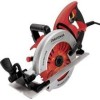Craftsman 28195 Product Manual - Page 10
to minimize
 |
View all Craftsman 28195 manuals
Add to My Manuals
Save this manual to your list of manuals |
Page 10 highlights
_k. DANGER: When sawing through a workpiece, the lower blade guard does not cover the blade on the underside of the workpiece. Always keep your hands and fingers away from the cutting area. Check the lower guard for proper closing before each use. Do not operate the saw if the lower guard does not move freely and close instantly. Never clamp or tie the lower guard in the open position. If the saw is accidentally dropped, the lower guard may be bent. Raise the lower guard with the retracting lever; the guard is operating properly when it moves freely, does not touch the blade or any other part in all angles and depths of cut, and readily returns to the closed position. Check the operation and condition of the lower guard spring. [f the guard and the spring are not operating properly, they must be serviced before use. The lower guard may operate sluggishly due to damaged parts, gummy deposits, or a buildup of debris. Do not operate your saw until the damaged part has been repaired or replaced. * The lower guard should be retracted manually only for making special cuts, such as pocket or compound cuts. Always raise the lower guard by retracting its lever. As soon as the blade enters the material, the lower guard must be released. For all other sawing, the lower guard should be allowed to operate automatically. Always make sure that the lower guard is covering the blade before placing the saw on a workbench or floor. Make note of the time it takes for the blade to stop spinning after the switch is released. An unprotected moving blade will cause the saw to travel backwards, cutting whatever is in its path. Never hold the piece being cut in your hands or across your legs. It is important to support the workpiece properly in order to minimize body exposure, blade binding, or loss of control. Hold tool by insulated gripping surfaces (handles) when performing an operation where the cutting tool may contact hidden wiring or its own cord. Contact with a "live" wire will make the exposed metal parts of the tool "live" and shock the operator. Always clamp the workpiece securely so it will not move when making the cut. Always use a rip fence or straight edge guide when performing rip cuts. This improves the accuracy of the cut and reduces the chance of the blade binding. * Always use blades that have the correct size and shape (diamond vs. round) arbor holes. Blades that do not match the mounting hardware of the saw will run erratically and cause loss of control. * Never use damaged or incorrect blade washers or bolts. The blade washers and bolts were specially designed for your saw for optimum performance and safety of operation. * Never cut more than one piece at a time. Do not stack more than one workpiece on the worktable at a time. 28195 Manual_Revised_07-0623 Page 10















